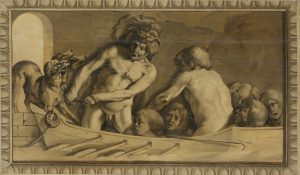Gates of Hell on Earth: The Underworld and its Entrances

The Ancient Greeks and Romans had a strong perception of life and death. Gods manifested in almost every aspect of their lives, through myths and their oral tradition. The Pantheon acted as a foundation for their cosmology. But as much as they developed divine concepts for every aspect of life, they also did with death and the afterlife. Two of the most famous masterpieces of Ancient Literature, the Iliad, the Odyssey, and the Aeneid, allow us to grasp a few concepts related to this and the underworld and its entrances.
From Literature
The Homeric poets were unaware of the notion of Elysian fields, a place for the blessed is never mentioned. According to the passage from the Iliad XX verse 67, Hades is described as a shadowy, humid area with a landscape of burial mounds. A dark beach next to the river of woe, Acheron, which can only be crossed by the boat of Charon. The area is also guarded by a monstrous three-headed hound, Cerberus.
From the beginning, we can see elements that are repeated in the realm of the dead: a monstrous creature acting as a gatekeeper, and the persistent idea of water and darkness, but it is not exactly ‘underground’, instead it is the place where the light of Helios never shines.
The Odyssey Book X verse 487, describes the kingdom of Hades, the Underworld, in greater detail, giving it a geographical location within the earth, on a distant shore of the Ocean, farther than the abode of the sun and the world of dreams.
Hesiod in the Theogony recovers this idea of territory in the confines of the flat earth, beyond the Ocean that surrounded the world and the Garden of the Hesperides. This was his vision of the “Underworld”.

Hercules Gets Cerberus from the Underworld, Charon, the Ferryman of the Styx, Jacob van Campen, 1645 – 1650
It is Hesiod who incorporates Tartarus as part of Hades. Also, his Works and Days mentions for the first time the Fortunate Isles as part of the idyll of the Elysian Fields, a paradise reserved for the greatest heroes of myths. But there is also a place for those who were not renowned for their deeds, a place for the commoners, the old, the young, and the weak. It is a place secluded from life for the dead. A dark world that resembles Helheim, for all those who were not considered heroes in life.
The dominions of Hades in the Homeric texts are described in a similar way to the domain of Hel: a ruler who rules a palace with gardens, fields, servants, cattle. Here the emphasis is placed on the term itself and the epithets that accompany the name “Hades”, the invisible one, that of invisible domains. The dead are sometimes described wandering these domains which they call “gray asphodel meadows” in reference to these pale plants. These are described as shadows without their consciousness, in a warning to Odysseus in Odyssey XI, verse 576.
The afterlife world is observed throughout the emblematic works that shaped them, those texts which captured the views and concerns of the men and women of their era.
The most distinctive and common to all of them is the sunless location of the world of the dead. It always refers to a realm of darkness, cold, and mist, located at the ends of the world and opposite to the place where the gods dwell. They are closed territories from which it is not possible to get out, not even for the gods themselves. It is a land protected by a gigantic beast, and it has a custodial entity that interrogates or demands something from the passerby; a place where corpses “exist” and remain for all eternity, without any awareness of their existence, without reason or feelings.
With these ideas, we can think of the vision of the afterlife that very different ancient cultures possessed, always agreeing that the dead were in a separate and divided place from the world of the living. A place that did not necessarily contemplate the possibility of return or a resurrection. And more importantly, the idea of punishment and torment for the deceased.
The ideas of death, torment, and punishment are later and eminently linked to Christianity.
To Real Locations
The river Acheron actually exists and it is located northwest of Greece and belongs to the Epirus region. In the Odyssey Book X, Odysseus used this river to enter the Underworld. These were the directions given by the witch Circe to Odysseus and his crew.
“So I spoke, and the beautiful goddess straightway made answer: ‘Son of Laertes, sprung from Zeus, Odysseus of many devices, [505] let there be in thy mind no concern for a pilot to guide thy ship, but set up thy mast, and spread the white sail, and sit thee down; and the breath of the North Wind will bear her onward. But when in thy ship thou hast now crossed the stream of Oceanus, where is a level shore and the groves of Persephone— [510] tall poplars, and willows that shed their fruit—there do thou beach thy ship by the deep eddying Oceanus, but go thyself to the dank house of Hades. There into Acheron flow Periphlegethon and Cocytus, which is a branch of the water of the Styx; [515] and there is a rock, and the meeting place of the two roaring rivers. Thither, prince, do thou draw nigh, as I bid thee, and dig a pit of a cubit’s length this way and that, and around it pour a libation to all the dead, first with milk and honey, thereafter with sweet wine, [520] and in the third place with water, and sprinkle thereon white barley meal.”

Cape Matapan, also known as Taenarum or Cape Tenaron, is the geographical location in the tip of the Peloponnese, by the edge of Lake Avernus. The legendary hero Hercules (Herakles) and Aeneas used this entrance to reach the Underworld. The myth of Orpheus also mentions this location related to the underworld, offering the path to the tragic figure who attempted to recover his wife from the Realm of the Dead. The Aeneid, book VI reads:
What else the Sibyl said. Straightway they find
A cave profound, of entrance gaping wide,
O’erhung with rock, in gloom of sheltering grove,
Near the dark waters of a lake, whereby
No bird might ever pass with scathless wing,
So dire an exhalation is breathed out
From that dark deep of death to upper air :—
Hence, in the Grecian tongue, Aornos called. (…)
An altar dark, and piled upon the flames
The ponderous entrails of the bulls, and poured
Free o’er the burning flesh the goodly oil.
Then lo! at dawn’s dim, earliest beam began
Beneath their feet a groaning of the ground :
The wooded hill-tops shook, and, as it seemed,
She-hounds of hell howled viewless through the shade ,
To hail their Queen. “Away, 0 souls profane!
Stand far away!” the priestess shrieked, “nor dare
Unto this grove come near! Aeneas, on!
Begin thy journey! Draw thy sheathed blade!
Now, all thy courage! now, th’ unshaken soul!”
She spoke, and burst into the yawning cave
With frenzied step; he follows where she leads,
And strides with feet unfaltering at her side.
Sources
- Hesiod. Works and Days.
- Homer. The Iliad. The Odyssey.
- Longenecker, Richard N. (2003). “Cosmology”. In Gowan, Donald E. The Westminster
- Theological Wordbook of the Bible. Westminster John Knox Press.
- Virgilius. The Aeneid
- West, M. L. , European Poetry and Myth, OUP Oxford, 2007
- Featured image: Jan Brueghel the Elder – Aeneas and the Cumaean Sibyl in the Underworld







